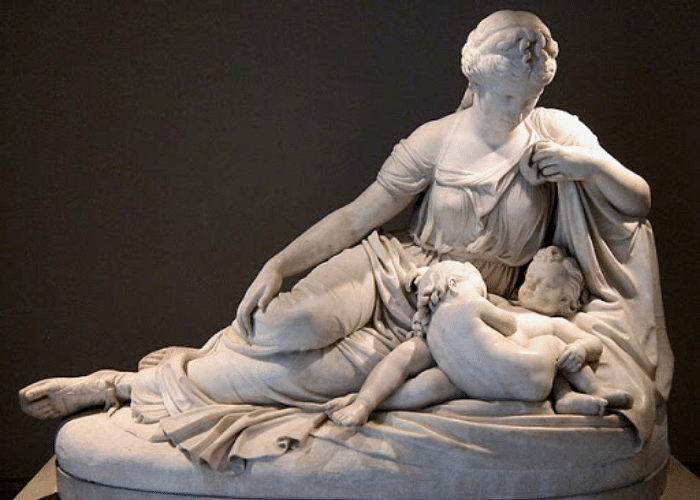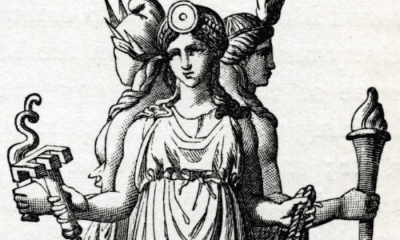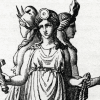
Greek
Leto: The Mother of Apollo and Artemis
Leto: The Mother of Apollo and Artemis
You might not have heard of Leto, but you have probably heard of her children. Here is the full story about the mother of Apollo and Artemis!
Many of the Titanesses faded into obscurity after the rise of the Olympian gods. A few, however, made a name for themselves within the new ruling pantheon.
One of these was Leto. The daughter of two of the elder Titans, her affair with Zeus produced the most famous twins in Greek mythology.
Leto would always be associated with her divine children, but as a character she was much more than a typical mother goddess.
From her maternal kindness to her terrible fury, here is everything you need to know about the mother of Artemis and Apollo!
The Birth of Leto’s Twins
Leto was a member of the second generation of Titanesses, the daughter of Coeus and Pheobe. Like many goddesses, her beauty attracted the attention of the king of the gods.
Zeus had originally sought Leto’s sister, Asteria. The goddess of the stars had run from him, however, eventually leaping into the Mediterranean to become a rock in order to make her escape.
With Asteria gone, Zeus noticed the beauty of her sister.
Leto soon became pregnant. This brought her to the attention of Hera.
Zeus’s wife was well-known for the anger she directed at her husband’s many mistresses. Leto was the latest goddess to be threatened by Hera’s wrath.
The queen of the gods was particularly threatened by Leto because of a prophecy she had heard regarding the Titaness’s pregnancy. It said that Leto would give birth to a son who would be loved by his father than Hera’s own son, Ares.
Hera took her anger out on Leto by trying to make the Titaness’s pregnancy impossibly difficult. She banned Leto from giving birth on solid ground.
Leto wandered the earth, searching for a safe place for her labor. The mainland and islands rejected her because of Hera’s curse and it seemed as though there would be nowhere for her to go.
Eventually, Leto found the stone that had once been her sister, Asteria. She asked it to rise to the surface of the water, where it became the floating island of Delos.
Because Delos was not affixed to the ocean floor it did not count as solid ground and provided Leto with a refuge. Still, her delivery would not be easy.
Hera went so far as to prevent Eileithyia, her daughter and the goddess of childbirth, from going to the Titaness’s side. Leto was forced to go into labor without the help of Eileithyia.
Other goddesses attended the birth however, acting as witnesses much as would happen in a royal court. While Hera was notably absent, Leto was attended by Themis, Rhea, Amphitrite, and Dione.
The presence of so many mother goddesses marked the birth as a particularly special occasion. It was obvious from the outset that Leto would become the mother of a very important deity.
In fact, she became the mother of two such deities. Leto gave birth to twins.
Her daughter Artemis was born first. Some myths said this was painless because Artemis was a destined protectress of childbirth.
Others said that without the assistance of Eileithyia the labor continued for nine days and nights. The other attending goddesses finally broke through the clouds Hera had hung around the goddess of childbirth to alert her to Leto’s need.
Artemis herself assisted as a midwife to the birth of her twin brother the next morning.
It was said that when Apollo was born, the land itself rejoiced at the arrival of such a perfect god. The island of Delos became filled with gold at the moment of his birth and was declared a sacred place.
The Goddess of Lycia
Leto came to be revered as the mother of two of Greece’s most important deities throughout the region, but her cult was strongest in Lycia.
The Anatolian region of Lycia, now a part of the country of Turkey, was home to an ancient culture known, but by the time most Greek myths were being written down had become almost entirely Hellenized.
Many modern scholars believe Leto originated in this region. While aspects of Greek culture spread to Asia Minor, she was one of the goddesses that was adopted by Greek colonists.
The name Leto might, in this interpretation, be traced back to the Lycian word lada, “wife.” The goddess revered in Lycia was not a secret mistress of an important god, but his wife.
The oldest evidence of Leto’s cult is found in Asia Minor, and even in later periods she appeared to be more revered there as a mother goddess than she was elsewhere in the Greek world.
In mythology, though, the Lycians were less quick to accept Apollo and Artemis’s mother.
According to Ovid, the Titaness wandered the world for a while after the birth of her twins. Hot and tired, she stopped by a pool of water in Lycia for a drink of water.
The local peasants did not accept her and tried to drive the tired goddess away from their pool. They stirred up the bottom of the pond, making the water dirty and brown.
Leto was a caring mother goddess, but she also had a fearsome temper. Her anger with the Lydians was swift.
She turned the inhospitable peasants into frogs. The people of Lydia learned to treat Leto with the respect she deserved.
The Assaults on Leto
While Leto could defend herself against mocking peasants, some assaults required a stronger response. For more violent punishments she had her children, who were faithful protectors of their mother.
Artemis and Apollo often came to their mother’s aid. One of the most famous instances of this was when she was attacked by the giant Tityus.
In most versions of the story, Tityus did not happen to find Leto on his own. He was sent by Hera, who was still set on seeing Leto suffer for her affair with Zeus.
The giant was sent with instructions to assault Leto, to hurt both her body and her reputation.
Luckily for Leto, her children were nearby when Tityus found her. As the giant lunged after her, she called out to her son and daughter for help.
Leto was a strong goddess, but not a fighter. Her children, however, were renowned for their skills in archery.
In moments, the giant was killed. Apollo and Artemis had each shot him several times for his attack on their mother.
Most sources agreed, however, that the story of Tityos did not end with his death. Leto was revered among the gods as well, and they ensured that the giant who attempted to harm her was punished for all eternity.
I [Odysseus in Haides] saw Tityos (Tityus) also, son of the mighty goddess Gaia (Gaea, Earth); he lay on the ground, his bulk stretched out over nine roods. Two vultures, one on each side of him, sat and kept plucking at his liver, reaching down to the very bowels; he could not beat them off with his hands. And this was because he had once assaulted a mistress of Zeus himself, the far-famed Leto, as she walked towards Pytho through the lovely spaces of Panopeus.
-Homer, Odyssey 11. 580 ff (trans. Shewring)
Leto was also attacked by the Python, the enormous serpent that guarded the oracle at Delphi. When her son inherited the oracle, Leto went with him to claim it.
Apollo killed the beast before it could harm Leto, but had to do penance for harming one of Gaia’s beloved children.
The creatures that attacked Leto were chthonic entities, creatures with an association with death and the underworld. The new deities of light and purity destroying these avatars of death in defense of the one who gave them life sent a clear signal that Apollo and Artemis, and by extension Leto, served as protectors.
The Pity of the Mother Goddess
As a mother goddess, Leto was known for her mercy and kindness. While she sometimes showed a horrible temper, she was more renowned as a maternal figure who helped those in need.
As her twin children often protected her from physical harm, Leto sometimes shielded them from misfortune. When Apollo killed the Cyclopes, for example, Leto’s intervention convinced Zeus to exile his son for a year instead of banishing him to Tartarus.
She also prevented her son from entering into a fight he would probably not have won. When Apollo and Heracles argued, Leto stepped between them to urge her son to peace.
Leto was known for her kindness to both humans and other gods. Some examples include:
- Orion – The giant was a companion of Leto and Artemis as they hunted. When he was stung by a venomous scorpion, in some stories leaping in front of Leto to save her, she Titaness ensured he was remembered by having his image placed in the sky as a constellation.
- Galateia and Leucippe – Galateia’s husband wanted a male heir and threatened to kill any daughters his wife bore. The woman attempted to disguise her daughter Leucippe as a boy, but was forced to flee the kingdom when the girl’s feminine beauty became apparent. Leto took pity on them both and changed Leucippe into a man so they could live safely.
- Aeneas – When the Trojan hero was injured in battle, Apollo dragged him to safety. Leto hid the wounded soldier and treated his injuries.
- Carneus – Leto and Apollo raised the son of Europa and Zeus, according to the poetess Praxilla.
- Prometheus – According to a Roman epic, Leto and her daughter pled the Titan’s case and finally convinced Zeus to allow Heracles to free him.
- The Palm Tree Dryads – During the Indian War of Dionysus, Leto and Apollo saved the dryads who accompanied the army from drowning. Apollo saved the laurels in honor of the nymph Daphne, while Leto paid special attention to the palm trees who had been beside her during her labor.
Niobe and Leto’s Wrath
Although she could be warm and nurturing, one of the most famous stories of Leto features her terrible wrath.
Niobe was the queen of Thebes, the wife of King Amphion. She had given birth to fourteen children, seven boys and seven girls, of whom she was exceedingly proud.
Her pride, however, crossed the line into hubris. Niobe bragged that she was better than Leto because the goddess had only one son and one daughter while she had given birth to so many.
According to Ovid, the arrogant queen even had the audacity to do so within Leto’s own temple. Niobe announced to the worshippers there that she was more worthy of praise than Leto for her beauty and fertility.
Leto was not a destructive deity, so she turned to her children to avenge her honor. Artemis and Apollo once again sprang to their mother’s defense.
The twins travelled to Thebes, armed with their bows. Apollo killed the sons of Niobe while Artemis slew the girls.
According to some version of the story, Apollo and Artemis each left one child alive so Niobe had no more claim to superiority.
When Amphion saw his dead children he swore vengeance on Leto. Zeus struck the king down with a thunderbolt to protect the mother of his children from retribution.
Leto, however, still had some measure of pity for Niobe. She transformed the queen into a mountain to end her grief.
Niobe’s tears formed the River Achelous, which cascaded down the mountain in waterfalls.
The Companion of the Twins
In both kindness and anger, Leto was a constant companion of her son and daughter. In both art and literature, she is almost always depicted beside one or both of them.
Leto was fond of music, of which her son was the patron god. In gatherings of the gods she is often shown dancing along to the music made by Apollo’s iconic lyre.
Stories that mentioned Leto often showed her in the forest with her children as well as at Olympus. The mother goddess, acting in a somewhat unexpected manner, often joined her daughter during hunts.
One such story includes the detail of how Leto behaved when the hunt was over. As they left the forest, she pulled her veil back over her hair and straightened her clothes.
In the forest with her children, Leto acted the part of a nymph who enjoyed dancing and hunting without being concerned about propriety. But back on Mount Olympus she resumed the role of the proper matron and mother.
Leto the Mother of Gods
Leto was a Titaness who was loved by Zeus for her beauty. While he had originally chased after her sister Asteria, he began an affair with Leto when the elder sister escaped his pursuit.
When Leto became pregnant she became the target of Hera’s anger. Zeus’s jealous wife tried to make it impossible for her husband’s latest mistress to give birth.
Leto finally found refuge on the island of Delos, giving birth to twins who were destined to become great gods of Olympus. Artemis and Apollo became two of the most revered gods of the Greek pantheon.
The twin archers were staunch protectors of their mother, saving her from several attacks by chthonic beings.
Leto was a kind and maternal goddess who was known for her mercy. She also had a terrible temper, though, and took sometimes violent revenge on those who insulted her.
Leto was revered for her role as the mother of two of Greece’s most important gods. Rarely seen without one or both of them, the mother of Apollo and Artemis earned her place on Olympus through her devotion to its favorite deities.




